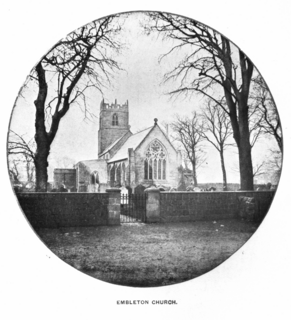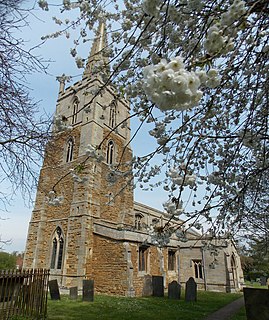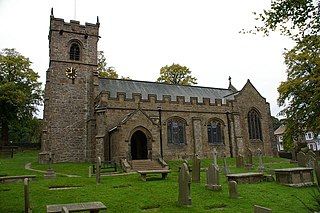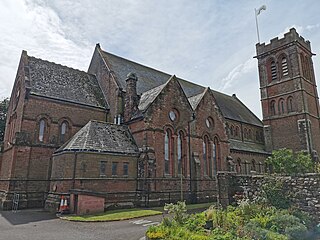
Battlesden is a hamlet and civil parish in the Central Bedfordshire district of Bedfordshire, England. It is just north of the A5, between Dunstable and Milton Keynes. According to the 2001 census, it had a population of 38. Because of its low electorate, it has a parish meeting rather than a parish council. It is in the civil parish of Milton Bryan.

St Bartholomew's Church is in the town of Colne in Lancashire, England. It is an active Anglican parish church in the Diocese of Blackburn. There has been a church on the site since no later than the 12th century although the present building mostly dates from the 16th century. It is recorded in the National Heritage List for England as a designated Grade I listed building.

St Nicholas is a Church of England parish church in Leeds, Kent first built in the 11th century with additions in the next five centuries. It is a Grade I listed building.

The Church of St Michael in Alnham, in the English county of Northumberland, is a medieval structure dating from circa 1200. Built on a Roman camp site, it is mentioned in records dating to 1291; it is a Grade I listed building.

The Church of the Holy Trinity is located in Embleton, Northumberland, England. The church, dedicated to the Holy Trinity, is west of the village. Built in the form of a cross, it consists of a two aisle nave, a clerestory, a chancel, a porch, and a chantry chapel. It has a tower with a small vestry, and a gallery. The vicarage house and garden are on a gradual slope on the south side of the churchyard. Traces of stonework show evidence of an earlier church from the 12th century. It is a Grade I listed building.

St Mary's is a parish church in Lenham, Kent begun in the 12th century with additions in the next three centuries. It is a Grade I listed building.

St John the Baptist's Church is a parish church in Marley Road, Harrietsham, Kent dedicated to John the Baptist. It was begun in the late 11th century or in the 12th century and works continued to the 15th century. The church is a Grade I listed building.

All Saints' Church is a 13th-century pilgrims' Grade I listed church in Boughton Aluph near Ashford, Kent. It is part of the Church of England.

All Saints Church is a parish church in Hollingbourne, Kent. It was begun in the 14th century and is a Grade I listed building. The church contains numerous monuments to the local Culpeper family.

All Saints is a parish church in Ulcombe, Kent. It was begun in the 12th century and is a Grade I listed building.

St Peter's and St Paul's Church is a parish church in Yalding, Kent, dedicated to saints Peter and Paul. It was begun in the 13th century and is a Grade I listed building.

The church of St Mary the Virgin is an Anglican parish church in the village of Hanbury, Worcestershire. Its earliest parts date from about 1210 and it is a Grade I listed building. The church was the family church for the Vernon family of nearby Hanbury Hall.

St Catherine of Siena Church is an Anglican parish church in Cocking, a village in the district of Chichester, one of seven local government districts in the English county of West Sussex.

St John the Evangelist's Church is a Grade I listed Church of England parish church dedicated to John the Evangelist, in Corby Glen, Lincolnshire, England. The church is 9 miles (14 km) south-east of Grantham, and in the South Kesteven Lincolnshire Vales. It is noted in particular for its 14th- and 15th-century medieval wall paintings.

St Nicholas' Church is a Grade I listed parish church in the village of Berden, Essex, England.

St Mary and St Peter's Church is a Grade I listed Church of England parish church dedicated to Saint Mary and Saint Peter in Harlaxton, Lincolnshire, England. The church is 2 miles (3 km) south-east from Grantham, and at the eastern edge of the Vale of Belvoir in South Kesteven.

St James the Great Church is a Grade I listed Church of England parish church dedicated to James, son of Zebedee in Aslackby, Lincolnshire, England. The church is 7 miles (11 km) north from Bourne, and in the Aslackby and Laughton parish on the eastern edge the South Kesteven Lincolnshire Vales.

St Leonard's Church is in the village of Downham, Lancashire, England. It is an active Anglican parish church in the diocese of Blackburn. The tower dates from the 15th century, and the rest of the church was rebuilt in 1909–10. The church is recorded in the National Heritage List for England as a designated Grade II* listed building.

St Margaret's Church is a 13th-century Church of England church in the village of Whaddon, Gloucestershire, England. It has been a grade II* listed building since 10 January 1955. The church tower is a dominant feature within the surrounding flat area.

St Mary & St Michael is in Egremont, Cumbria, England. It is an active Anglican parish church in the deanery of Calder, and the diocese of Carlisle. Its benefice of Egremont with Bigrigg & Haile. The church is a grade 2 listed building.





















